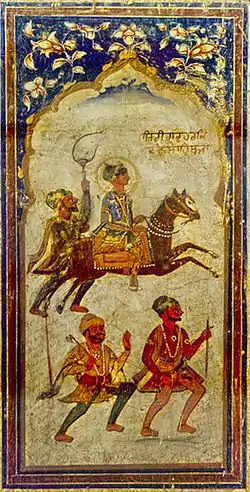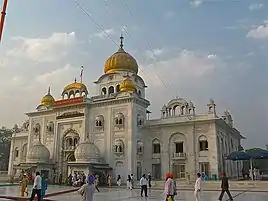Guru Har Krishan
Guru Har Krishan (Gurmukhi: ਗੁਰੂ ਹਰਿ ਕ੍ਰਿਸ਼ਨ, pronunciation: [ɡʊruː həɾ kɾɪʃən]; 17 July 1656 – 9 April 1664[1]) was the eighth of the ten Sikh Gurus. At the age of 5, he became the youngest Guru in Sikhism on 7 October 1661,[1] succeeding his father, Guru Har Rai.[2] He contracted smallpox in 1664 and died before reaching his eighth birthday. It is said that he died because he contracted smallpox while successfully curing his followers.[3]
Guru Har Krishan ਗੁਰੂ ਹਰਿ ਕ੍ਰਿਸ਼ਨ | |
|---|---|
 A fresco of Guru Har Krishan, ca. 1745 | |
| Other names | Bal Guru, The Eighth Master |
| Personal | |
| Born | Kishan Das Sodhi July 7, 1656[1] |
| Died | March 30, 1664 (aged 7)[1] |
| Cause of death | Smallpox |
| Religion | Sikhism |
| Spouse | none |
| Children | none |
| Parents | Har Rai Mata Krishen |
| Other names | Bal Guru, The Eighth Master |
| Senior posting | |
| Period in office | 1661–1664 |
| Predecessor | Guru Har Rai |
| Successor | Guru Tegh Bahadur |
| Part of a series on |
| Sikhism |
|---|
 |
He is also known as Bal Guru (Child Guru),[2] and sometimes spelled in Sikh literature as Hari Krishan Sahib.[3][4] He is remembered in the Sikh tradition for saying "Baba Bakale" before he died, which Sikhs interpreted to identify his granduncle Guru Tegh Bahadur as the next successor.[2][3] Guru Har Krishan had the shortest reign as Guru, lasting only 2 years, 5 months and 24 days.
Biography
Har Krishan was born in Kiratpur (Shivalik Hills) in northwest Indian subcontinent to Krishen Devi (Mata Sulakhni) and Guru Har Rai. His father, Guru Har Rai supported the moderate Sufi influenced Dara Shikoh instead of conservative Sunni influenced Aurangzeb as the two brothers entered into a war of succession to the Mughal Empire throne.[5] After Aurangzeb won the succession war in 1658, he summoned Guru Har Rai in 1660 to explain his support for the executed Dara Shikoh. Guru Har Rai sent his elder son Baba Ram Rai to represent him. Aurangzeb kept the 13 year old Ram Rai as hostage, questioned Ram Rai about a verse in the Adi Granth – the holy text of Sikhs. Aurangzeb claimed that it disparaged the Muslims.[6][7] Ram Rai changed the verse to appease Aurangzeb instead of standing by the Sikh scripture, an act for which Guru Har Rai excommunicated his elder son, and nominated the younger Har Krishan to succeed as the next Guru of Sikhism.[6][8]
Aurangzeb meanwhile rewarded Ram Rai, patronizing him with land grants in Dehra Dun region of the Himalayas. A few years after Guru Har Krishan assumed the role of Sikh leader, Aurangzeb summoned the young Guru to his court, with an apparent plan to replace him with his elder brother Ram Rai as the Sikh Guru. However, Har Krishan contracted smallpox when he arrived in Delhi and his meeting with Aurangzeb was cancelled. On his deathbed, Har Krishan said, "Baba Bakale", and died in 1664. The Sikh religious organization interpreted those words to mean that the next Guru is to be found in Bakale village, which they identified as Guru Tegh Bahadur, the ninth Guru of Sikhism.[5][3]
Authentic literature with more details about Guru Har Krishan's life and times are scarce and not well recorded.[9] Some of biographies about Guru Har Krishan, particularly about who his mother was, were written in the 18th century such as by Kesar Singh Chhibber, as well as in the 19th century, and these are highly inconsistent.[10]
Lesson in humility
Sikh Gurus have been known to impart lessons in humility during their lifetimes. One such famous incident as noted by Macauliffe in Sikh Religion - Vol 4 is from the life of Guru Har Krishan. Once on the way to Delhi from Punjab, Guru Har Krishan was staying at Panjokhara, near present day Ambala. Gurudwara Panjokhra sahib is situated on this place now. A very learned pundit by the name of Lal Chand, noting that the guru's name was similar to that of Lord Krishna, came visiting with the intent to test him on the knowledge of Bhagavad Gita by asking the meaning of a few shalokas. The guru, with the intention to cure him of his pride, said that Lal Chand does not need the guru for this task and that anyone could do that. On hearing this, Lal Chand brought a mute and ignorant water carrier called Chhajju. The guru placed his stick on Chhajju's head. Macauliffe writes "The Brahman and the water carrier accordingly began to discuss, and the water carrier gave such learned replies, that the Brahman stood in astonished silence before the Guru." He accordingly begged Har Krishan's pardon for his mistake and became the Guru's disciple.[11]
Visiting Raja Jai Singh and death in Delhi
One of the most famous Gurdwara of Sikhs in North India, Gurdwara Bangla Sahib was at that time the residence (bangla is indic term for bungalow) of Raja Jai Singh of Delhi. Raja Jai Singh humbly requested the Guru to come to Delhi, so that he and the Guru’s Sikhs may behold him.[12]
Because of the Guru’s young age, the Raja’s wife too wanted to test his spiritual powers. Disguising herself as a maid, she sat amongst the lady attendants. However, the Guru instantly identified her and sat on her lap, proclaiming, “This is the Rani”, thereby convincing her of his spiritual powers.[13][14]
It was during his stay here that a deadly disease of smallpox and cholera had spread in the city of Delhi. When people learned of Guru Har Krishan's presence there, they went to him for shelter and protection. Guru Har Krishan asked them to bathe in the well in the Bungalow to cure themselves. Anyone who took a bath there recovered.[15]
Gallery
 Gurudwara Bangla Sahib, where the Guru died
Gurudwara Bangla Sahib, where the Guru died
 History of Gurudwara Panjokhra Sahib, Haryana
History of Gurudwara Panjokhra Sahib, Haryana
See also
References
- Mohindar Pal Kohli (1992). Guru Tegh Bahadur: Testimony of Conscience. Sahitya Akademi. pp. 12–13. ISBN 978-81-7201-234-2.
- HS Singha (2009), The Encyclopedia of Sikhism, Hemkunt Press, ISBN 978-8170103011, pages 96–97
- Louis E. Fenech; W. H. McLeod (2014). Historical Dictionary of Sikhism. Rowman & Littlefield Publishers. p. 148. ISBN 978-1-4422-3601-1.
- Pashaura Singh; Louis E. Fenech (2014). The Oxford Handbook of Sikh Studies. Oxford University Press. p. 951. ISBN 978-0-19-100412-4.
- Arvind-Pal Singh Mandair (2013). Sikhism: the Guide for the Perplexed. Bloomsbury Academic. pp. 50–51. ISBN 978-1-4411-0231-7.
- Har Rai: Sikh Guru, Encyclopædia Britannica (2015)
- J. S. Grewal (1998). The Sikhs of the Punjab. Cambridge University Press. pp. 67–69. ISBN 978-0-521-63764-0.
- William Owen Cole; Piara Singh Sambhi (1995). The Sikhs: Their Religious Beliefs and Practices. Sussex Academic Press. pp. 33–34. ISBN 978-1-898723-13-4.
- Pashaura Singh; Louis E. Fenech (2014). The Oxford Handbook of Sikh Studies. Oxford University Press. p. 41. ISBN 978-0-19-969930-8.
- Surjit Singh Gandhi (2007). History of Sikh Gurus Retold: 1606–1708 C.E. Atlantic Publishers. pp. 590–591 with note 2. ISBN 978-81-269-0858-5.
- Macauliffe (1909). Sikh Religion - Vol4 p. 321. Oxford. pp. 321–322.
- Macauliffe (1909). Sikh Religion - Vol4 p. 320. Oxford. p. 320.
- Macauliffe (1909). Sikh Religion - Vol4 p. 324. Oxford. p. 324.
- "Guru Harkrishen And Gurdwara Bangla Sahib".
- Macauliffe (1909). Sikh Religion - Vol4 p. 323. Oxford. p. 323.
External links
| Preceded by Guru Har Rai |
Sikh Guru 6 October 1661 – 30 March 1664 |
Succeeded by Guru Teg Bahadur |